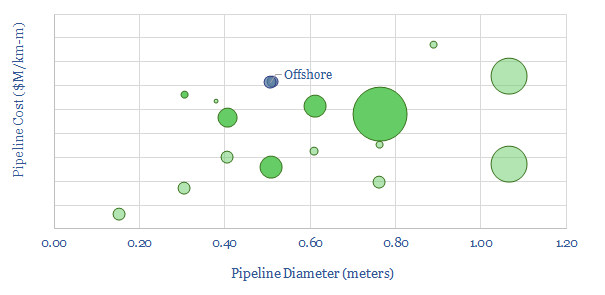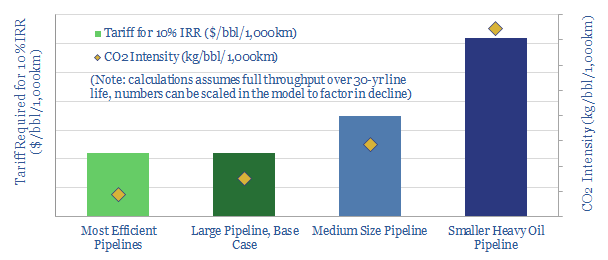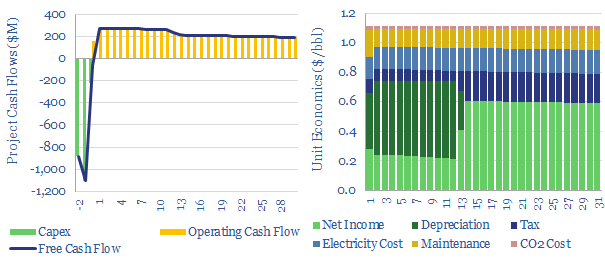Pipeline costs are modeled in this data-file. $1/bbl is needed to move oil, oil products and other liquid commodities around 500 km at Mbpd scale, and the energy requirements are around 2.1 kWh/bbl, emitting 0.8 kg/bbl of CO2. Economics of scale matter. As a rule of thumb, costs rise by 100% when volumes fall by 50%.
This model captures the energy economics of a pipeline carrying oil, oil products, chemical feedstocks, water or debatably, super-critical CO2 (once it is already super-critical). Although note that gas-phase flows are captured in our gas pipeline model, as the physics are very different (gases are compressible).
Our base case model covers a large, 1-meter pipeline, carrying 1Mbpd of light crude oil c500km and sees a $1/bbl pipeline tariff needed to generate a 10% unlevered IRR.
The largest cost in a pipeline is capex. A good rule of thumb is that a pipeline will cost $1-2M per km, but it varies depending on the pipeline size, location and terrain. Useful underlying data are collated in the data-file, from past projects, to bottom-up studies.

The energy costs of a large pipeline can be approximated at around 0.5 kWh per bbl per 100km, however the physics are broken down in the data-file. The total power requirement is the sum of static head (overcoming gravity) and dynamic head (overcoming friction).
Dynamic head will be the larger contributor to the overall energy consumption of a liquids pipeline, and is a function of velocity^2, 1/pipeline diameter, the ‘smoothness’ of the pipe and the viscosity of the fluid being transported.
Our conclusions show the requisite costs, energy and CO2 intensities of different pipelines (below). Generally wider pipelines, correctly sized, with smooth internal surfaces will be the most energy efficient and have the lowest CO2 intensities.

You can stress test the economics directly in the model, by varying pipeline tariffs, capex costs, energy costs, CO2 prices, maintenance costs, pipeline diameter, pipeline distance, pipeline elevation, pipeline materials, fluid viscosity and pump efficiencies.
All of our research into midstream pipelines is indexed here, while we think the energy transition will bring opportunities to move new projects, including more feedstocks, hydrogen and CO2 for CCS.
